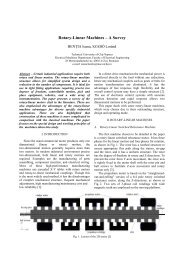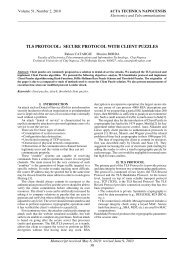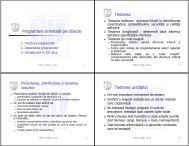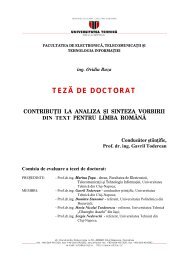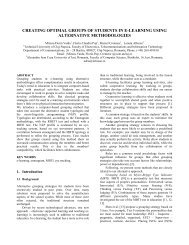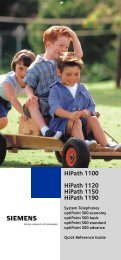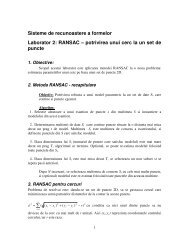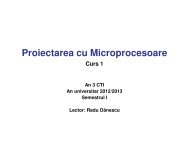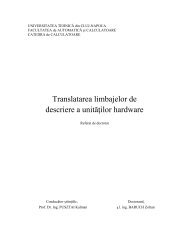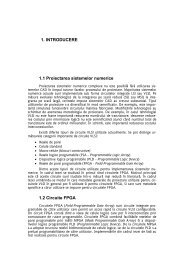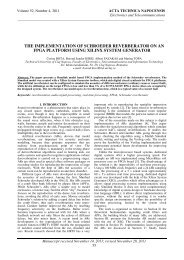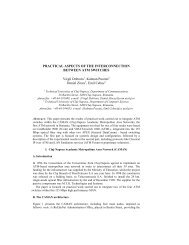LTE Emulator
LTE Emulator
LTE Emulator
Create successful ePaper yourself
Turn your PDF publications into a flip-book with our unique Google optimized e-Paper software.
TUCN – Data Transmission Laboratory<br />
6. Compatibility with 3GPP standards. Possible developments<br />
6.1. Compatibility with E-UTRA standards<br />
To evaluate the compatibility of the present version 1 (drop 1) of the emulator and simulator<br />
with the 3GPP E-UTRA standards the following aspects are considered:<br />
30<br />
1. the physical layer for the downlink transmission – frame structure, transmission scheme,<br />
link adaptation;<br />
2. data transfer at layer 2 (MAC and RRC) – frame structures, buffer management, ARQ and<br />
HARQ operations, mapping of the logical channels on the transport channels;<br />
3. QoS concepts, service bearer architecture and scheduling/rate control operations (Dynamic<br />
Resource Allocation – DRA or Packet Scheduling - PS);<br />
The compatibility analysis regarding the uplink connection (physical layer and layer 2),<br />
management and transmission on signaling channels and mobility management can be performed<br />
only after the implementation or at least the design of the blocks in discussion in the emulator<br />
and in the simulator. Paragraph 6.2. presents several considerations regarding the insertion of the<br />
blocks mentioned above in the implemented emulator-simulator and the processing required.<br />
1. Compatibility at the physical layer - downlink.<br />
The [3GPP07] standard proposes for the downlink physical layer (chapter 5 [3GPP07]) the<br />
following features:<br />
o a 10ms radio frame composed of 20 slots with 0.5ms duration (an alternative variant for<br />
the TDD duplex mode contains 12 slots). 12 consecutive OFDM sub-carriers during one<br />
slot period compose a resource block. This resource block corresponds practically to a<br />
chunk (or bin) and has duration of one TTI interval. Several resource blocks can be<br />
allocated to a service (user). The employment of pilot sub-carriers inside the resource<br />
block is not specified (at least until the elaboration of the present material). The OFDM<br />
sub-carrier separation can be 15 kHz or 7.5 kHz and the used cyclic prefix varies from<br />
on resource block to other (see [3GPP07 chapter 5]). Some of the first and last OFDM<br />
symbols of the radio frame are used to transmit some information regarding the resource<br />
allocation, ARQ/HARQ processes, ACK/NACK signaling, uplink scheduling and<br />
reference signals for cell identification;<br />
o turbo codes are proposed as coding techniques, one code being used for the data of all<br />
resource blocks associated to a layer 2-connection. The QPSK, 16QAM or 64QAM<br />
modulations are considered, the same modulation being used in all resource blocks<br />
associated to a layer 2-connection. The modulation technique and the parameters of the<br />
coding techniques can be modified adaptively from one slot to another. Static or<br />
semi-static (combination of static and adaptive) use of modulation and coding techniques<br />
is also allowed;<br />
o the standard also includes the possibility to use multi-antenna techniques with 2 or 4<br />
transmit antennas and the use of power control;<br />
The simulator associated to the implemented emulator has the following features:<br />
o it allows the use of chunks with variable dimensions, the modification of OFDM<br />
modulation parameters, but the cyclic prefix is the same for all the OFDM symbols. It<br />
does not offer the possibility to use some groups of OFDM symbols for the transmission<br />
of signaling information;<br />
o it uses a single LDPC code on a group of chunks associated to a layer 2-connection and<br />
the allowed modulation techniques are 2PSK, QPSK, 16QAM and 64 QAM and<br />
optionally 256QAM. The modulation techniques can vary adaptively from one chunk to<br />
other, thus providing a higher flexibility in modifying the instantaneous bit rate;



